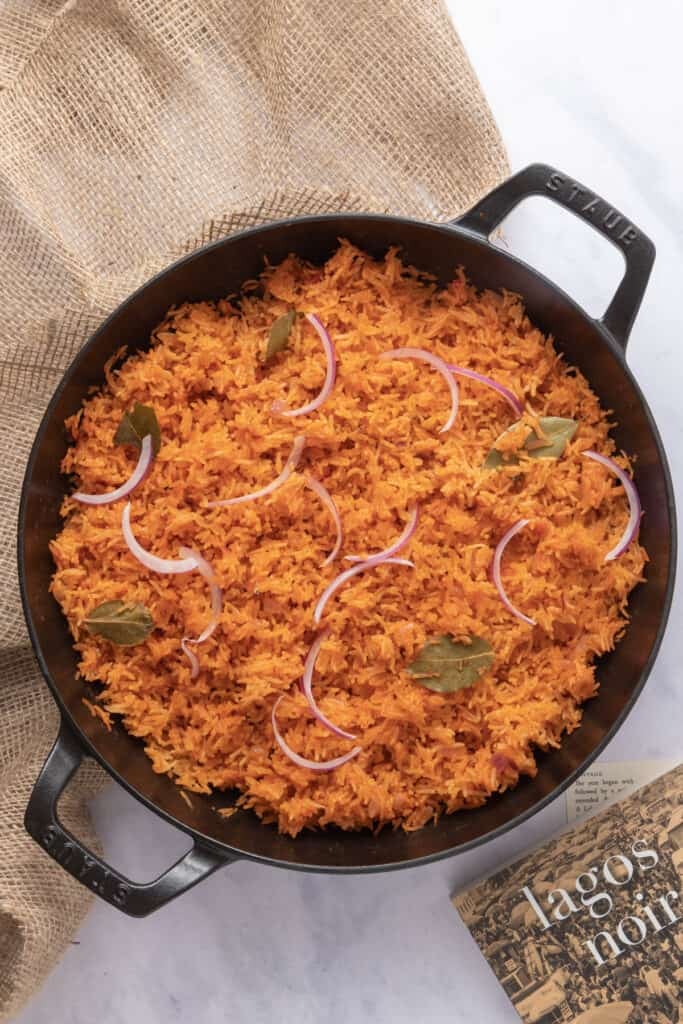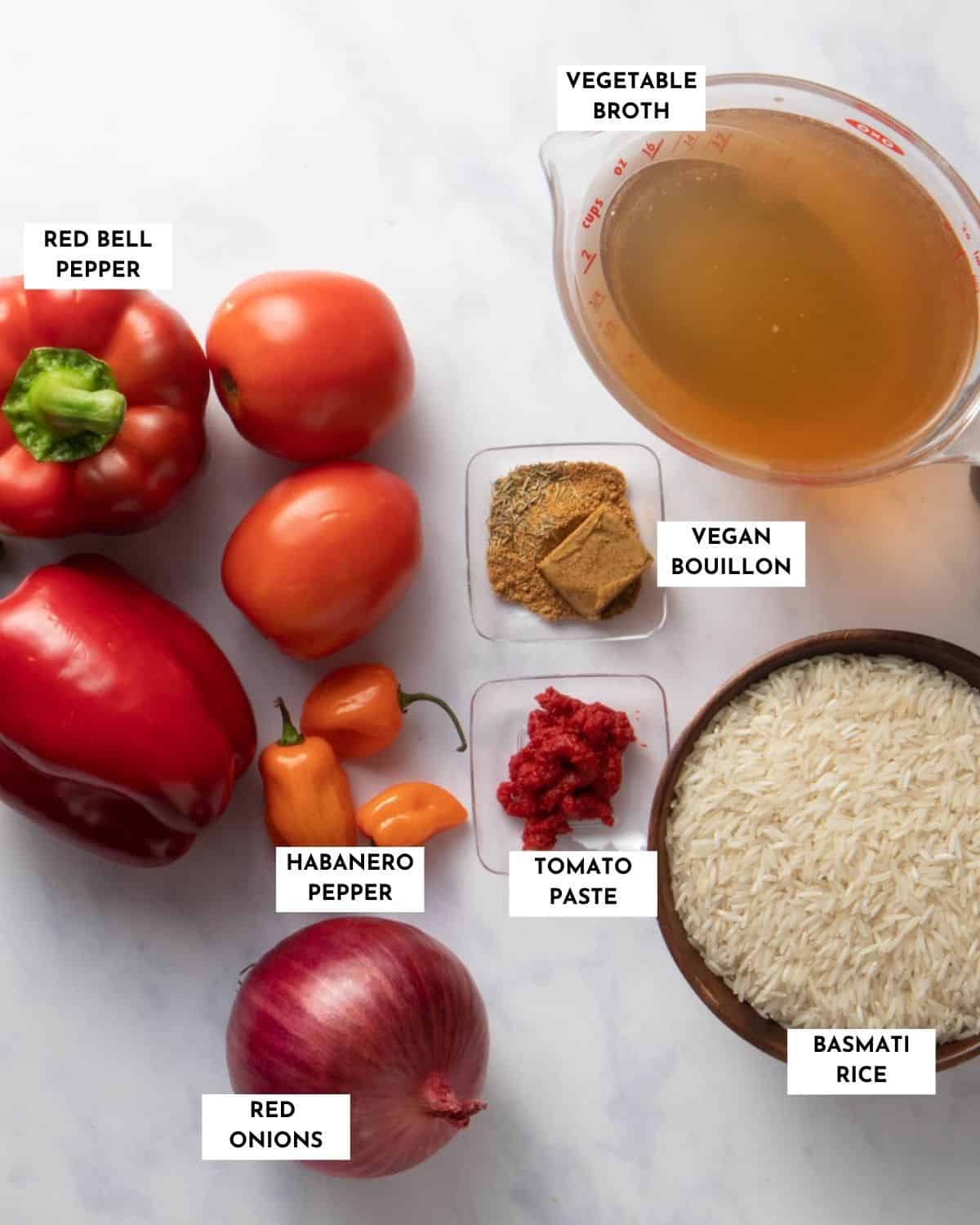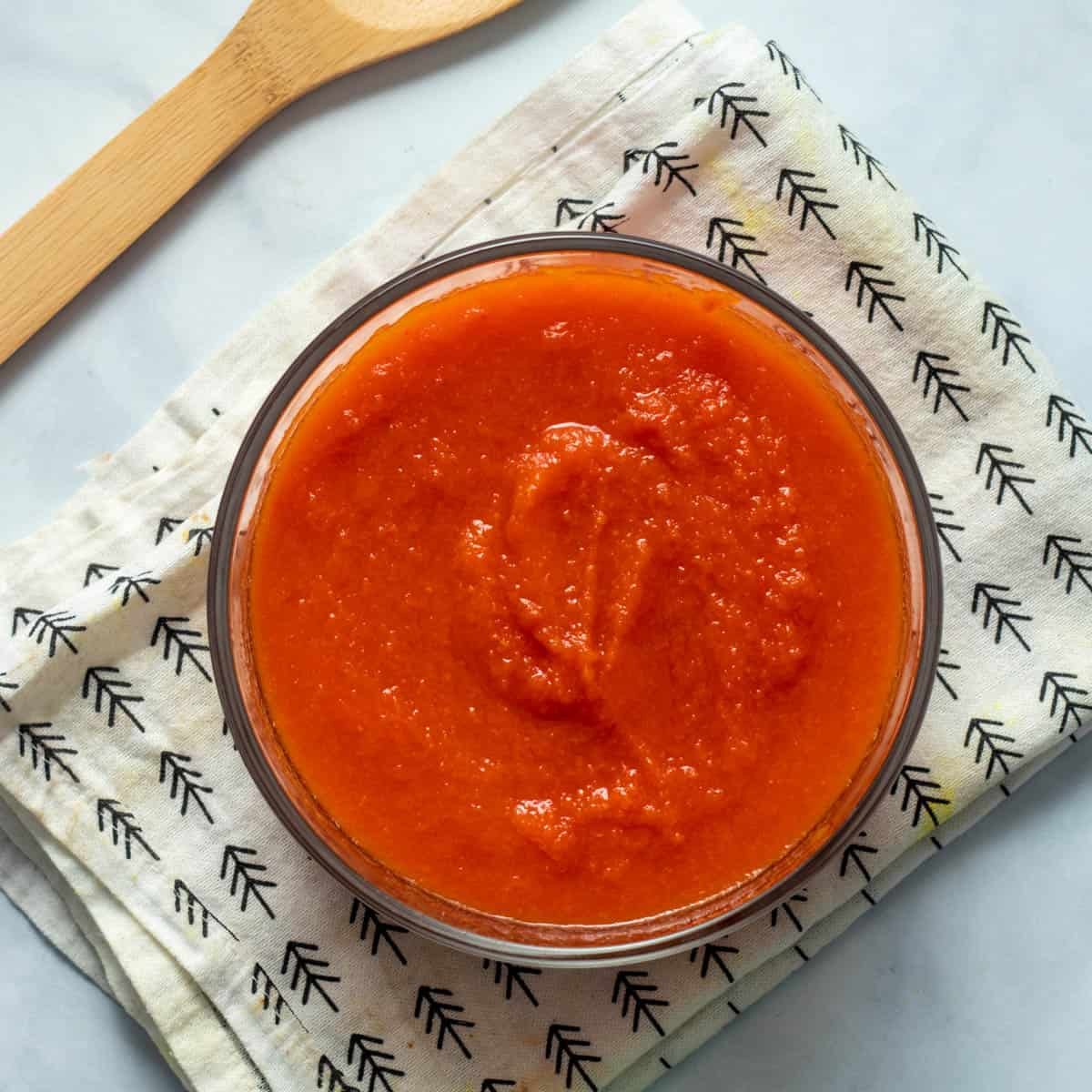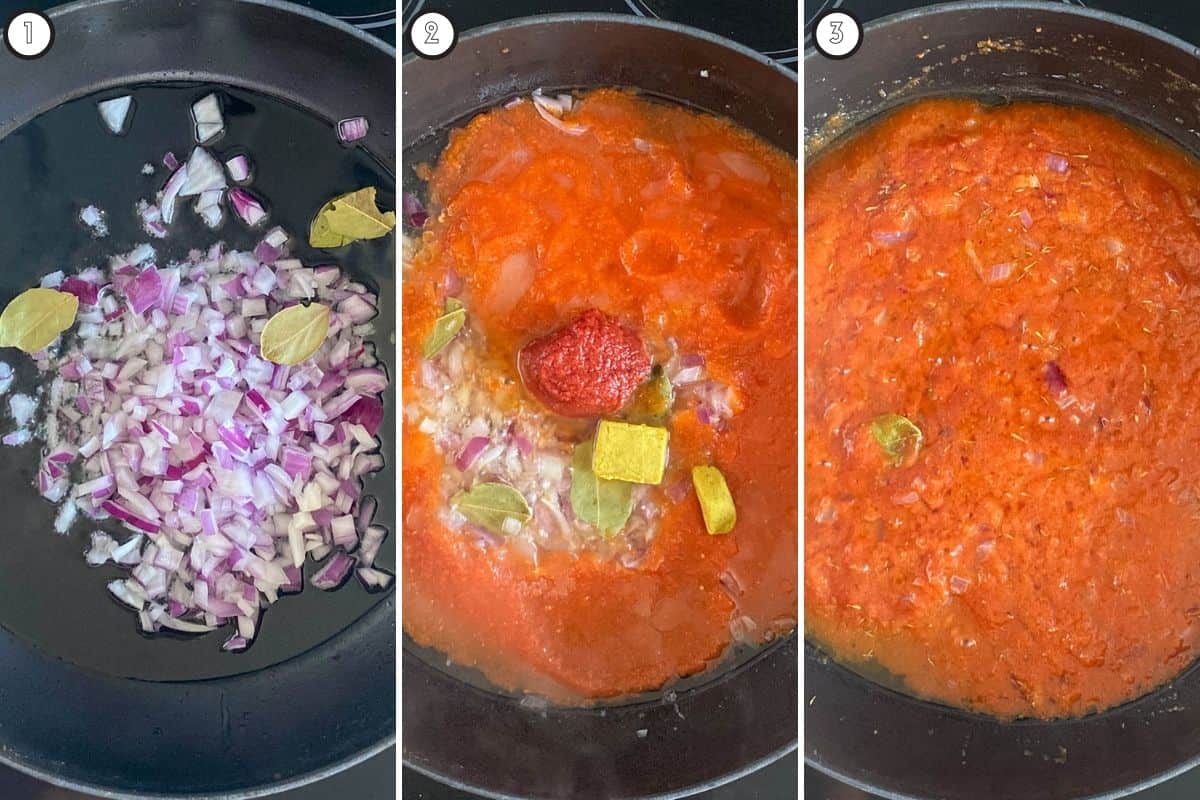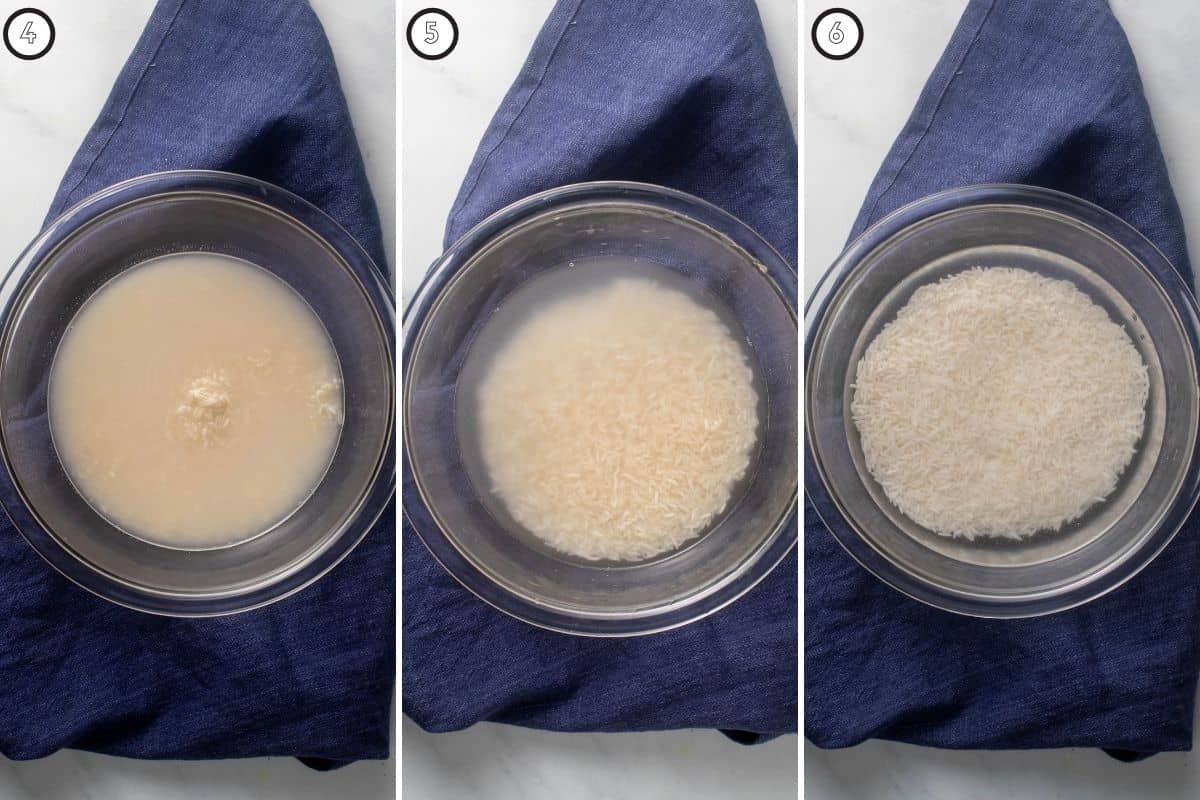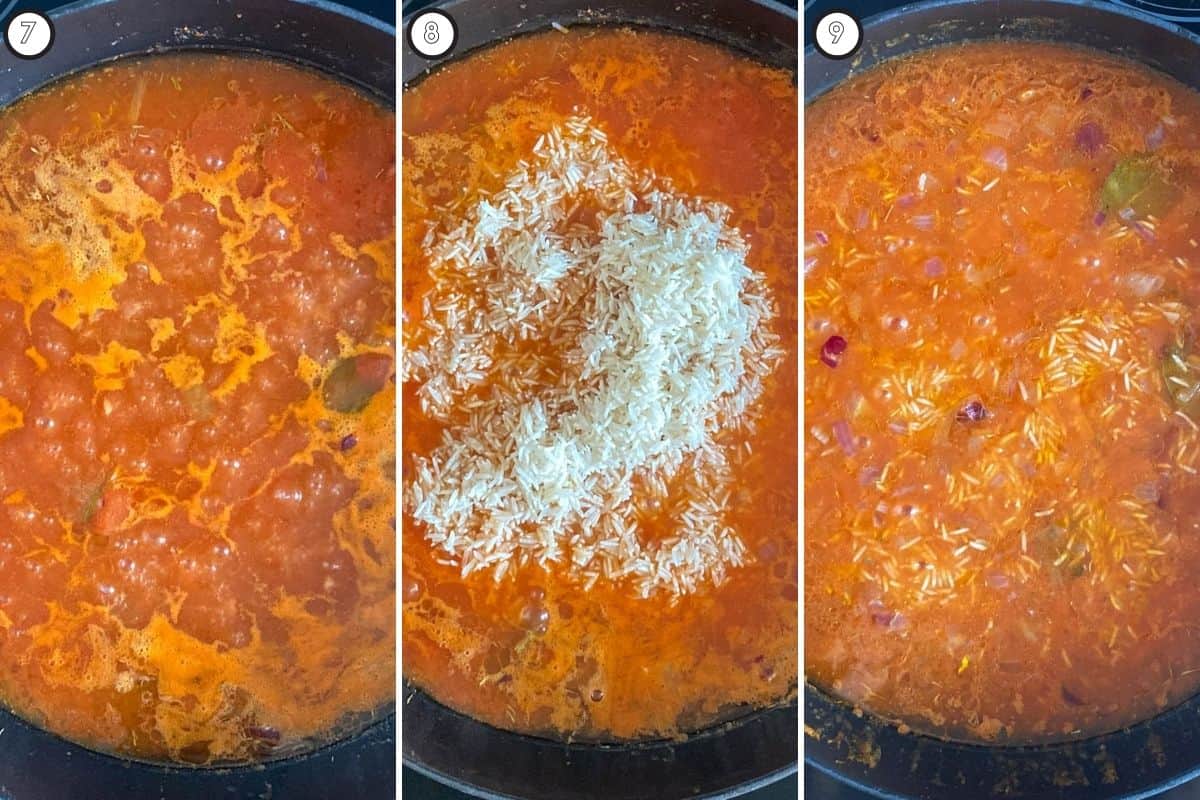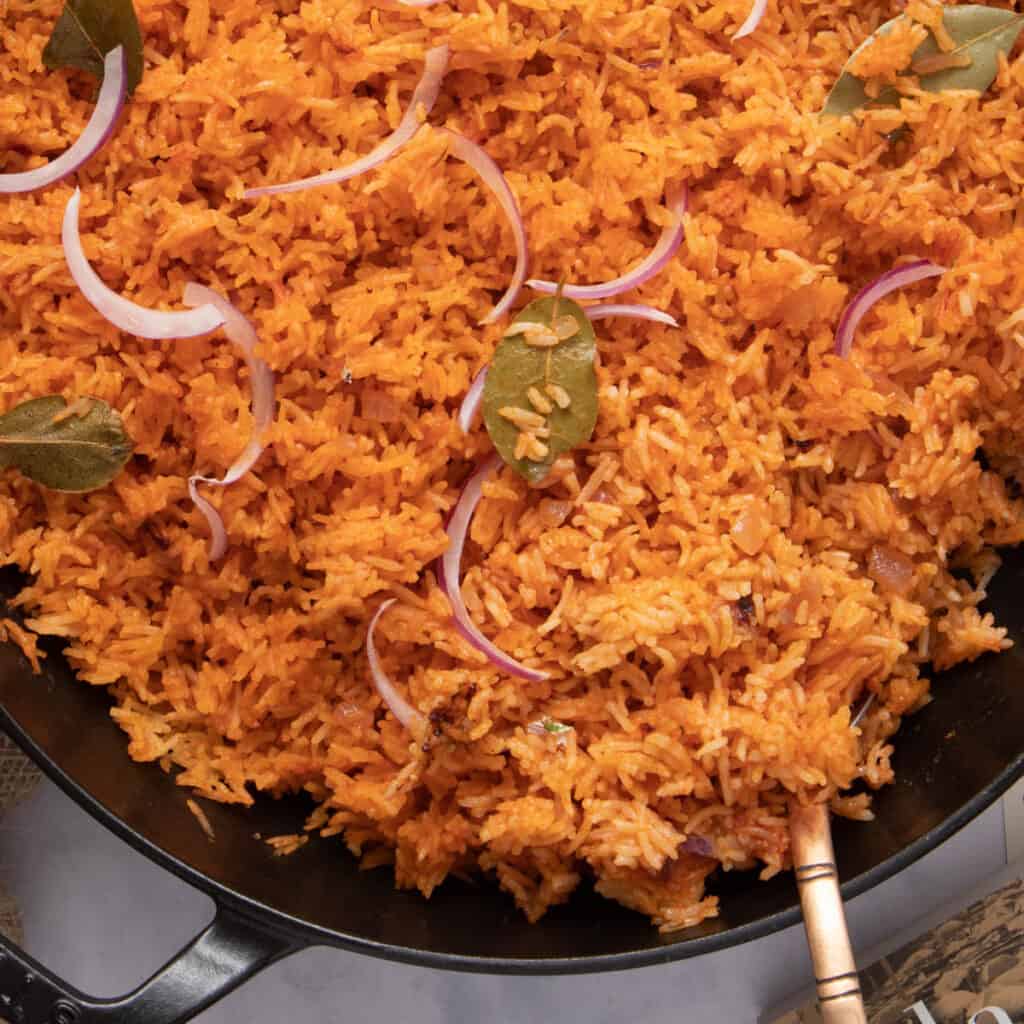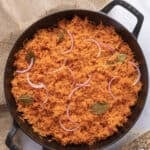This post contains helpful tips and tricks! If you’re in a rush, please use the “Jump to Recipe” above!
💭 Why you’ll love this recipe
My partner is from Lagos, Nigeria, and considers any dish without meat an affront to his existence. As a dutiful Yoruba spouse and lifelong vegetarian, I wanted to find a Nigerian dish we could both enjoy. Thankfully, I didn’t have to look too far!
Ready in 30 minutes. This recipe comes together in barely any time and it is so delicious, and hearty! If you want an Instant Pot version, check out this Instant Pot Jollof Rice. Great for make-ahead meals. I typically make a huge batch and we tend to eat it with different curries and mains through the week. It also freezes excellently.Versatile and super simple to customize. You can easily adjust the spice levels, use whatever rice you have on mind, or adjust the spice base with flavors that are more familiar.
⭐ What is Jollof Rice?
Jollof rice is a West African red pepper rice, similar to dirty rice in the South. As Portuguese trading posts were set up on the Senegal River Delta, tomatoes made their way to West Africa. This recipe originated in Senegal, from the Wollof people. It’s commonly believed that a shortage of barley led a local cook to use rice, and modern-day jollof rice was born (Benachin, aka, one pot). One school of thought suggests that the influence of jollof rice has been felt in the American South, where West African slaves from rice-growing regions introduced the “red rice” concept. Modern-day dishes like jambalaya and gumbo are believed to derive some influence from jollof rice! So, this recipe lays out the connection between West African cuisine and modern-day Southern “red” cuisine.
Notes & Variations
Scotch Bonnet vs. habanero pepper: The traditional Nigerian recipe uses Scotch Bonnet pepper. But that can sometimes be hard to find, but habanero pepper works just as well. To adjust the spice levels, you can remove the seeds of the pepper, or simply leave it out. It still tastes delicious! No blender? No problem. Though unconventional, you can actually just use marinara sauce and add some habanero sauce (blasphemous, but you gotta get by sometimes) My sister-in-law runs a catering business in Nigeria and she was the one who gave me this tip! Use long grain parboiled rice. Parboiled rice is a type of long-grain rice that has been partially cooked before milling. This process gives it a firmer texture and makes it less likely to become sticky. If you can’t find parboiled rice, you can use regular long-grain rice, but be sure to rinse it thoroughly before cooking.Use a good quality tomato paste. Tomato paste is one of the key ingredients to make Nigerian Jollof Rice, so it’s important to use a good quality product. Look for a tomato paste that is 100% tomatoes and without added sugar or salt. If you don’t have tomato paste, check out these tomato paste substitutes (including tomato sauce, crushed tomatoes).
Nigerian vs. Ghanaian Jollof Rice
There is a ton of debate on where jollof originated, and which jollof rice is the best (sparking online wars). But I’ll say - jollof rice, to me, is a dish that every household has their own recipe for. It’s like a Thanksgiving turkey, or cornbread. And my jollof rice is based on my sister-in-law’s recipe (aka, it’s the real deal). There are a couple of key differences between Nigerian and Ghanaian jollof.
Nigerian jollof uses long grain, parboiled rice (most commonly consumed). Ghanaian jollof uses softer, non-parboiled rice (typically something like jasmine rice) Ghanaian jollof also has a wider variety of spices (I’ve eaten some with clove, for instance) - but Nigerians keeps it simpler (typically just bouillon).
📋 Ingredients & Notes
What is the best rice for jollof?
This is a raging debate! The most common options are long-grain rice, basmati rice, and Thai jasmine rice. There’s a trend towards bulgur as a healthy option. Traditional long grain rice tends to hold the consistency the best, but I prefer basmati because it cooks a bit softer. For the oven, Thai jasmine works best.
♨️ Make the best Nigerian Jollof rice
Blend roughly chopped red peppers, fresh tomatoes, onions and habanero peppers to make the base sauce. I use this sauce directly to make jollof.
If you have time and want to intensify the flavor, you can parboil the base to evaporate excess water to make the Nigerian pepper sauce. You can make this in a big batch and have it on hand almost all the time. If you go this route: use around 200 ml (80% of a cup) per 2 cups of rice.
Sauté some onions and bay leaves, then add the base sauce to fry it. Use a deep and wide pan with a tight-fitting lid. Add about ⅓ cup of vegetable oil (this seems like a lot but you’re going to basically fry off the sauce).
Add chopped onions and fry for 1-2 minutes. Then, add bay leaves and thyme and sauté for a minute.
Now, add the tomato paste, tomato base, and bouillon and fry the sauce. At this step, you can also add curry powder if you wish. But the key is to get the base sauce nicely fried with the onions and spices. I cook this covered for 1 to 2 minutes to get the raw taste out of the pepper sauce.
While the sauce is cooking, rinse your rice thoroughly. Not rinsing rice properly is one of the biggest mistakes that leads to mushy jollof! So, rinse the rice under cold water really well (typically 3 times until the water runs clear).
Now, add the broth (if you’re using 2 cups of rice, use 1 and ¾ cup of broth) to the pepper sauce. Add salt, and if you wish, black pepper or white pepper to taste. I use vegetable broth, but you can also use chicken any other stock you have. The broth usually has some salt, so watch how much salt you use.
Cover the lid and increase the heat to a medium-high and boil. Typically, this takes about 3 to 4 minutes.
Add the rinsed rice to the pot and give it a good stir so it’s evenly distributed. Cover with tight-fitting lid and cook covered for at least 12 minutes.
Once the rice is rinsed, add this to the pot and give it a good stir so it’s evenly distributed. Cover with the tight-fitting lid and cook covered for at least 12 minutes.
Check at the 12 minute mark to see how fluffy your rice is, and give it a good mix again. Cook for another 2 to 3 minutes until the rice is fully cooked. Move it off the heat, open the lid and let it vent the steam for a few minutes. Serve hot!
How do you adjust the spice level?
The pepper sauce is the heart of any Jollof rice recipe. But every person’s spice palette is different. If you have low spice tolerance, play safe the first time and then increase the peppers the next time, versus the other way around.
To intensify flavors, you can parboil the sauce (i.e. simmer on low heat for about 30 minutes) to get a more concentrated flavor. This is the base which we use for making a variety of dishes (like vegan red pepper alfredo or my vegan Nigerian efo riro).To reduce the pepper flavor, play with the mix of tomatoes and red peppers, or eliminate the habanero peppers entirely.
🍴 Three tips for perfect Nigerian jollof rice
Wash your rice first! Extra starch can turn the rice super mushy if you’re not careful about it. Typically, I measure the rice into a mixing bowl, fill it with COLD water, and use my hands to wash the rice. I typically wash it twice before I cook it. Use 1:1 water to rice ratio, and cook on medium heat. Jollof rice uses steam infusion to cook - not boiling. You don’t want to overcook the rice! Some people use aluminum foil in addition to a tight fitting lid but this is optional. Check your rice halfway through the cook time. I typically check my jollof rice halfway through and give the rice a good stir before closing the lid again. This makes sure that you’re not burning any of the bottom rice. Fluffy, delicious jollof.Don’t overcrowd the pot. It’s important to give the rice enough room to cook evenly. If you overcrowd the pot, the rice will steam instead of fry, and it won’t be as flavorful.
This classic Nigerian jollof rice is built on my sister-in-law’s recipe and has taken me nearly a year, and several attempts to perfect. But thankfully, I was able to troubleshoot some common problems so hopefully you don’t have to. There are two common problems - the rice burns, or it gets too mushy. Here are tips for preventing or salvaging the dish if that happens.
🍴 Serving and storage suggestions
Typically, Nigerian jollof rice is served with meat or stews (like this Efo Riro). As a vegetarian, I sometimes serve it with vegan drumsticks, or even this sheet pan aloo gobi. Don’t come after me!
To store jollof rice, just wait for it to cool down completely, throw it in an airtight container and put it in the fridge. It’ll stay well for at least 3-4 days. You can just microwave the portion of the rice you want to eat when you want to eat it.
Freezing is also super simple. First make sure that the rice is completely cooled down, then put it in an airtight container. When you’re ready to eat, make sure you thaw the rice first, then spread in a baking sheet, and throw it in the oven (15 minutes at 350F after it comes to room temperature).
More Nigerian and African vegetarian recipes:
If you loved this Nigerian Jollof Rice, try these other recipes:
Authentic West African Pepper Sauce (Nigerian)Nigerian Efo RiroEthiopian Misir Wot (Red Lentil Stew) Ethiopian Atakilt Wat (Cabbage Stir Fry) Ethiopian Gomen Wat (Spiced Collard Greens)
📖 Recipe
